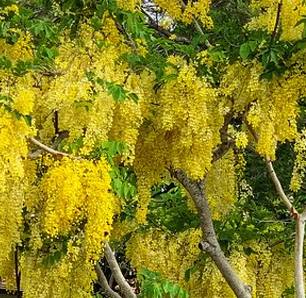The golden rain tree is classified as a Sapindaceae (soapberry) family deciduous tree of medium height. It grows to a height and width of 30–40 feet and is resistant to drought, heat, wind, and pollution, making it an ideal urban blooming tree. It features a rounded crown and spreading branches.
Manchuria, Korea, Japan, and China are the original habitat of the golden raintree. In 1763, it was initially introduced to North America. It is currently on the Invasive Plant List maintained by the National Park Service’s Mid-Atlantic Exotic Plant Management Team.
Pros
The Golden Rain tree is known for multiple uses. These trees, with their deep root systems, provide adequate shade for shade-tolerant plants. This flexible tree fits numerous landscaping applications. This Golden Rain Tree is perfect for accent pieces or as an ornamental tree. Those who reside near traffic often wish to establish these trees along their property line. This species is immune to the harmful effects of urban pollution, and they can muffle the sound of such loud noises.
The Golden Rain tree has a reputation for being a resilient species. It’s a popular choice in tough urban areas because it can handle smog and abuse. But it’s also a good choice in numerous other locations because it can grow in any soil type and needs very little water. They can grow to be between 30 and 40 feet tall and broad, which is big enough to provide shade but not so enormous that they overtake the garden, threaten to lift the pavement or drop branches on the home. Golden Rain Trees are ideal for modest front yards because they provide visual appeal throughout the year.
Cons
Diseases and pests rarely pose a problem for golden Rain Trees. But in some regions of the nation, it tends to proliferate by seed, taking over entire landscapes in unwanted places. It is even capable of displacing native species and spreading into natural areas.
Care
This Golden Rain tree can adapt to different soil types and can survive in urban settings. This tree grows in USDA zones 5–9. In its natural habitat, the Golden Rain tree can reach a height of 15–25 feet and a width of the same. This species has a medium-to-fast growth rate, with an average annual height gain of 13–24 inches.
The golden rain tree’s low maintenance requirements add to its beauty. It is advised to water this tree monthly for the first two years and mulch the trunk to keep it weed-free. They don’t always shape themselves, so careful pruning is needed. If necessary, prune off smaller branches to preserve an open crown with a uniform distribution of leaves, and remove branches that make an extremely wide or narrow-angle with the trunk.
Problems
Golden Rain Trees cannot survive extreme cold. Damage caused by frost can occur, particularly at the tips of branches. The wood is extremely brittle and susceptible to storm damage. Twig kill can also occur in severe winters. The tree blows over in windy locations due to its weak root system.
Diseases
Insects and diseases don’t pose any significant threats to the Golden Rain Tree. Cankers, coral spot fungus, and root rot are some of the diseases that it may be susceptible to at times. Verticillium wilt can eventually cause the tree to die and cause the leaves to wilt. Scales are occasionally seen. These are protrusions on the bark that resemble scabs and are home to very little sucking insects. They don’t destroy the golden raintree; rather, they weaken it. Horticultural oil sprays are a useful tool for controlling scale. Boxelder bugs feed very little on this tree, but they can leave black stains on it from the excrement they leave behind. It can also become weedy and quickly reseed. It is also susceptible to damage during storms and the colder months due to its brittle wood.



